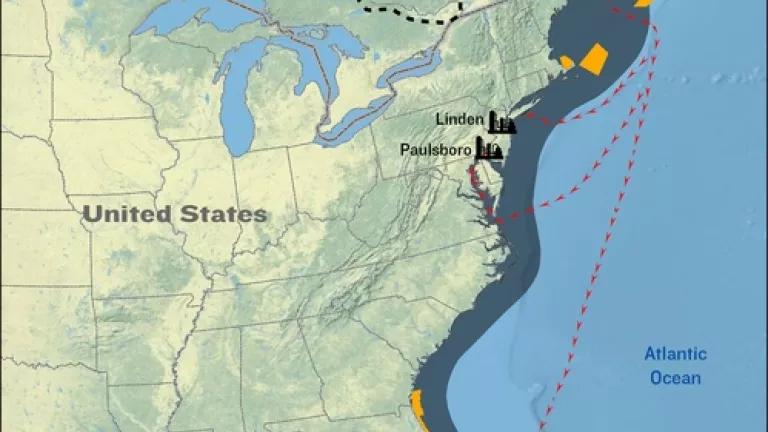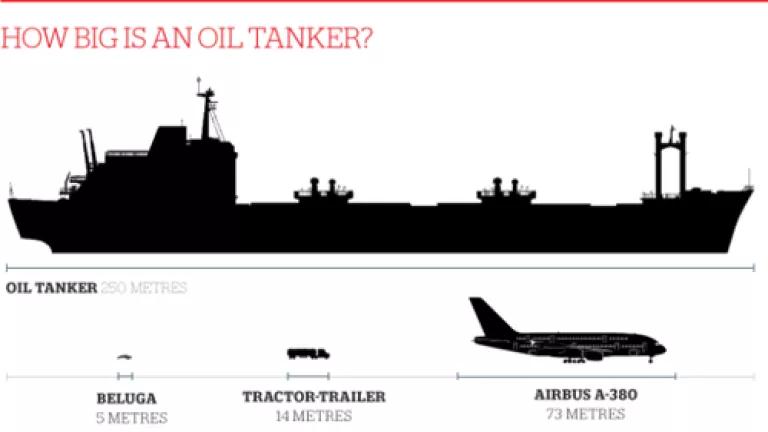
The company that lost a bid to build the Keystone XL tar sands pipeline (and has filed a lawsuit against the U.S. government for $15 billion for lost profits) is eyeing to get its tar sands oil to the Gulf Coast another way: by sea. TransCanada is proposing a scheme that would start as a pipeline in Alberta terminating at Canada's Bay of Fundy and then continue by supertanker moving tar sands through the Gulf of Maine, to Louisiana and Texas, with stops at major ports along the East coast and by the tip of Florida. So far, Canadian federal decision-makers are ignoring the risk that this proposal presents to U.S. coasts and fisheries even as the National Academy of Sciences has found that tar sands spills are more devastating than conventional oil to water sources and spill responders are unequipped for cleanups. But Canadian public opposition to the project is fierce as demonstrated by another major announcement that the City of Montreal and the Montreal Metropolitan Community representing 82 municipalities and nearly 4 million people are now officially opposed to the project.
TransCanada hopes Americans won't notice. They're calling it "Energy East," but let's call it what it is: Keystone East.
A tar sands pipeline and tanker scheme
Energy East would carry 1.1 million barrels of tar sands oil a day (bpd) from Alberta to New Brunswick; this is 35 percent larger than Keystone XL. The pipeline portion of the project would traverse Canada2,850 miles (4,600 kilometers). It would convert an aging natural gas pipeline in Saskatchewan, Manitoba, and Ontario (1,860 miles in length), and build new pipe in Alberta, Quebec, and New Brunswick (930 miles in length).
Based on an application submitted to Canadian regulators last month, most of the oil transported by Energy East would be loaded onto more than 280 oil supertankers carrying between 1 million and 2 million barrels that will travel down the U.S. east coast. Over the course of a year, this virtual pipeline by water would move up to 328 million barrels of tar sands oil down the east coast. This project would result in an increase five times more oil tanker traffic from current oil tanker traffic along the Atlantic seaboard every year.
Therefore, TransCanada's reincarnated Keystone plan--Energy East--is not just a new pipeline project. It is a pipeline-tanker scheme that would bring millions more barrels of tar sands oil to the United States. TransCanada first announced Energy East in 2013, but project changes have delayed the completion of the project's application. Going forward, Canada's National Energy Board must review the application to determine whether it is complete, a process expected to be complete in Spring 2016. To be clear, Canadian regulators have so far determined not to consider the risk of tar sands spills to the U.S. Atlantic and Gulf Coasts. The NEB will have 15 months to complete its review of the project. TransCanada hopes to finish building Energy East in 2020.
Hundreds of massive oil tankers
With Energy East adding hundreds of tar sands oil tankers to annual commercial vessel traffic on east coast waters, collisions would become more likely. Further south, tankers from Energy East are expected to navigate dangerously close to major population centers, entering the New York harbor en route to New Jersey refineries, and the Chesapeake Bay and Delaware River en route to Delaware refineries. As the majority of tankers round the tip of Florida, they must travel close to the Florida Keys before entering the Gulf of Mexico, a pathway that could place the Florida Keys National Marine Sanctuary at risk, not to mention southern Florida's significant tourism economy. Canada's Bay of Fundy, where the tar sands supertankers would be loaded and launched, is famous for its hazardous conditions, including the world's highest tides, dense fogs, and treacherous weather. A spill here could affect U.S. waters off Maine.

Tar sands spills pose unique risks to water
Here's what happens to tar sands oil spills in water: it sinks and causes long term toxic contamination. It is nearly impossible to clean up. This is according to the National Academy of Sciences whose December 2015 report confirms that tar sands oil (in its most common form--diluted bitumen) poses greater risks than other types of oil, leading to difficult spill response situations. The NAS concluded that first responders, governments, and industry lack the technology or expertise to effectively deal with tar sands spills.
Impact on whale habitat
At the Canadian port of Saint John, just north of the border with Maine, Energy East would yield a near 75% increase in current outbound tanker traffic--from 380 tankers per year to 661. And the nature of the products transported would change significantly--from refined petroleum products to unrefined crude oil. This would place in harm's way the critical feeding habitat for the 450 remaining North Atlantic right whales, as well as humpback, fin, Sei, and Minke whales, white-sided dolphins and harbor porpoises. These species are extremely vulnerable to noise pollution, ship strikes, and the threat of a severe oil spill from increased marine traffic. As Energy East's tankers travel down the East Coast, they would move near other important habitat areas off the coasts of Cape Cod and Florida.
Threats to multi-million dollar economies
The traffic created by the proposed pipeline places numerous ecosystems at risk, including the critical Bay of Fundy, the Gulf of Maine, the Acadia National Park, Cape Cod, and the Florida Keys. These areas host incredibly diverse wildlife that supports vibrant commercial fishing and tourism economies. Indeed, off the coast of Maine, lobstering is a multi-million dollar industry and a cultural icon for the region. But lobster are bottom-feeding organisms, and the threat posed by sinking tar sands oil to their health and the industries they support could not be more stark.
Adding the equivalent of 7 million new cars to the road
In addition to its effect on ocean habitat and coastal communities, Energy East stands to have significant climate consequences. In a report assessing the climate implications of the proposed pipeline, the Canadian-based Pembina Institute estimated that producing the crude needed to fill Energy East could generate up to 32 million metric tons of additional greenhouse gas emissions each year. On a lifecycle basis--from production to consumption--the oil moved by Energy East is expected to generate a staggering 220 million metric tons of greenhouse gases every year (equivalent to the annual emissions of 58 coal-fired power plants). Following the Paris climate negotiations and Canada's support of a 1.5° Celsius warming target, Energy East's construction would make it largely impossible for Canada to honor the emission reduction commitments this target will require.
But the political landscape has changed since TransCanada publicly announced the project in 2013. Opposition to Energy East is growing in Canada, especially among First Nations, due to the pipeline's negative environmental impacts and the risks it poses to local communities. In Quebec, where most of the new pipeline would need to be built, opposition is strong and growing. With the addition of the Montreal Greater community regional government, there are now 144 municipalities across the province in formal opposition. In neighboring Ontario, the government found the pipeline would pose significant environmental harm and bring no economic benefit to the province.
Given the overwhelming opposition to the Keystone XL proposal, Americans along the East Coast--and around the country--need to better understand the ramifications of this project-including its potential impact to marine life and local industries such as commercial fishing and tourism. A tar sands spill in ocean waters from one of these massive crude carriers could devastate a local tourism economy, or a regional fishery or lobster population. It's essential that we size up the potential risks this pipeline-tanker scheme could bring and weigh in, before it is too late.
